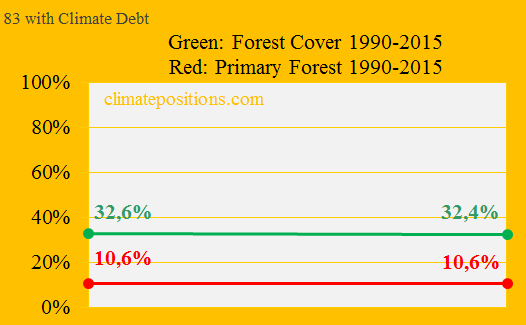Forest Cover and Primary Forests 1990-2015 (two country groups are examined)

This article is sourced from two publications by ‘FAO’: ‘Forest Ecology and Management 2015 (pdf 145 p)’ and ’Global Forest Resources Assessment 2015 (pdf 253 p)’. The latter contains 46 different tables¹ with 234 countries and territories forest development 1990-2015.
Primary Forest is defined as naturally regenerated forest of native species, where there are no clearly visible indications of human activities and the ecological processes are not significantly disturbed. Today, Primary forest accounts for 32% of global Forest Cover and has apparently increased by around 6.8% between 1990 and 2015, however, this increase is largely due to the fact that more countries have submitted data for the statistic. This taken into account, an overall global Primary Forest loss of 2.5%, since 1990, is more likely (and 10.0% loss in the tropics).
Primary forests are considered irreplaceable with unique qualities that make significant contributions to biodiversity, climate change mitigation, and sustainable livelihoods – with particular importance in tropical areas. One study from 2007 found that 25% of all species in Amazonian Brazil were unique to Primary Forests, and almost 60% of all species of tree and liana were recorded only in Primary Forests.
Seven countries accounted for 75% of the reported Primary Forests in 2015: Russia, Canada, Brazil, the Democratic Republic of the Congo, United States, Peru and Indonesia. Tropical countries that reported on their Primary Forests from 1990 to 2015, showed an overall decline of 10% between 1990 and 2015, and subtropical countries reported a decline of 2.5%. These declines were roughly in line with the rates of the overall Forest Cover loss for these domains. The reported increases of Primary Forests in temperate and boreal countries were accounted for almost entirely by Russia (boreal; 0.4% increase rate annually) and the United States (temperate; 0.3% increase rate annually).
82 countries have zero Primary Forests in all reporting years. Some of these countries have substantial Forest Cover, for example Spain, Germany, Greece, the United Kingdom, Angola, Mozambique, Tanzania and Zambia.
The two diagrams below reveal a different trend of Primary Forests and Forest Cover. 140 countries with full data both in ClimatePositions, and data of Forest Cover 1990-2015 and Primary Forests 1990²-2015, have been divided into two country-groups: A) 83 countries³ with ‘Climate Debt’ in ClimatePositions, and B) 57 countries without Climate Debt. Combined, the two country-groups cover 85% of the global Forest Cover and 82% of the global Primary Forests. Note that the 1990-data on Primary Forests in both country-groups are not quite consistent².
The first diagram shows the area change of Forest Cover and Primary Forests as share of the total land area of the 83 countries with Climate Debt. Although this group of countries bear the responsibility for the global warming, the area change of both forest categories is marginal (an increase would have mitigated the warming effects of greenhouse gas emissions). On average 32.7% of the Forest Cover was Primary Forests in 2015.
The second diagram shows the area change of Forest Cover and Primary Forests as share of the total land area of the 57 countries without Climate Debt. The development in this country group is discouraging both in terms of Forest Cover and Primary Forests. On average 25.1% of the Forest Cover was Primary Forests in 2015.
Similar diagrams of 176 countries are available in the menu ‘Calculations (Excel)’.
.
¹Selected examples of the 37 tables: Forest and other wooded land 2015 (Table 1), Other wooded land 1990-2015 (3), Deforestation 1990–2010 (5), Reforestation 1990–2010 (6), Forest characteristics 2015 (7), Primary forest 1990-2015 (8), Other naturally regenerated forest 1990-2015 (9), Planted forest 1990-2015 (10), Other naturally regenerated and planted forest 2015 (11), Mangroves 1990–2015 (12), Trends in forest growing stock 1990-2015 (14), Biomass stock in forest and other wooded land 2015 (18), Carbon stock in living forest biomass 1990-2015 (21), Production forest 1990-2015 (22), Total wood removals (24), Woodfuel removals (25), Conservation of biodiversity 1990-2015 (29), Conservation and protected forest areas 1990–2015 (31), Area affected by woody invasive species 2005-2010 (32), Total forest area burned 2003-2012 (34), Forest management plan 2010 and monitoring (39), Revenues, expenditures and contribution of forestry to GDP (44), and Employment in forestry 1990-2010 (46).
²Among the 74 countries with Climate Debt nine countries first reported Primary Forests in 2000 or 2005 and one country in 2010, and among the 57 countries without Climate Debt two countries first reported in 2005 and 2010.
³Among countries with Climate Debt only France and Dominican Republic are excluded due to lack of data on Primary Forests.
.
Updated data and diagrams of all ‘Indicators‘ and all countries in ClimatePositions are available in the menu ‘Calculations (Excel)‘.
Data on Forest Cover and Primary Forests are from ‘FAO’: ‘Forest Ecology and Management 2015 (pdf 145 p)’ and ’Global Forest Resources Assessment 2015 (pdf 253 p)’.
Photo of rainforest is from ‘www.pexels.com/photo‘, 2016.
Comments are closed.

